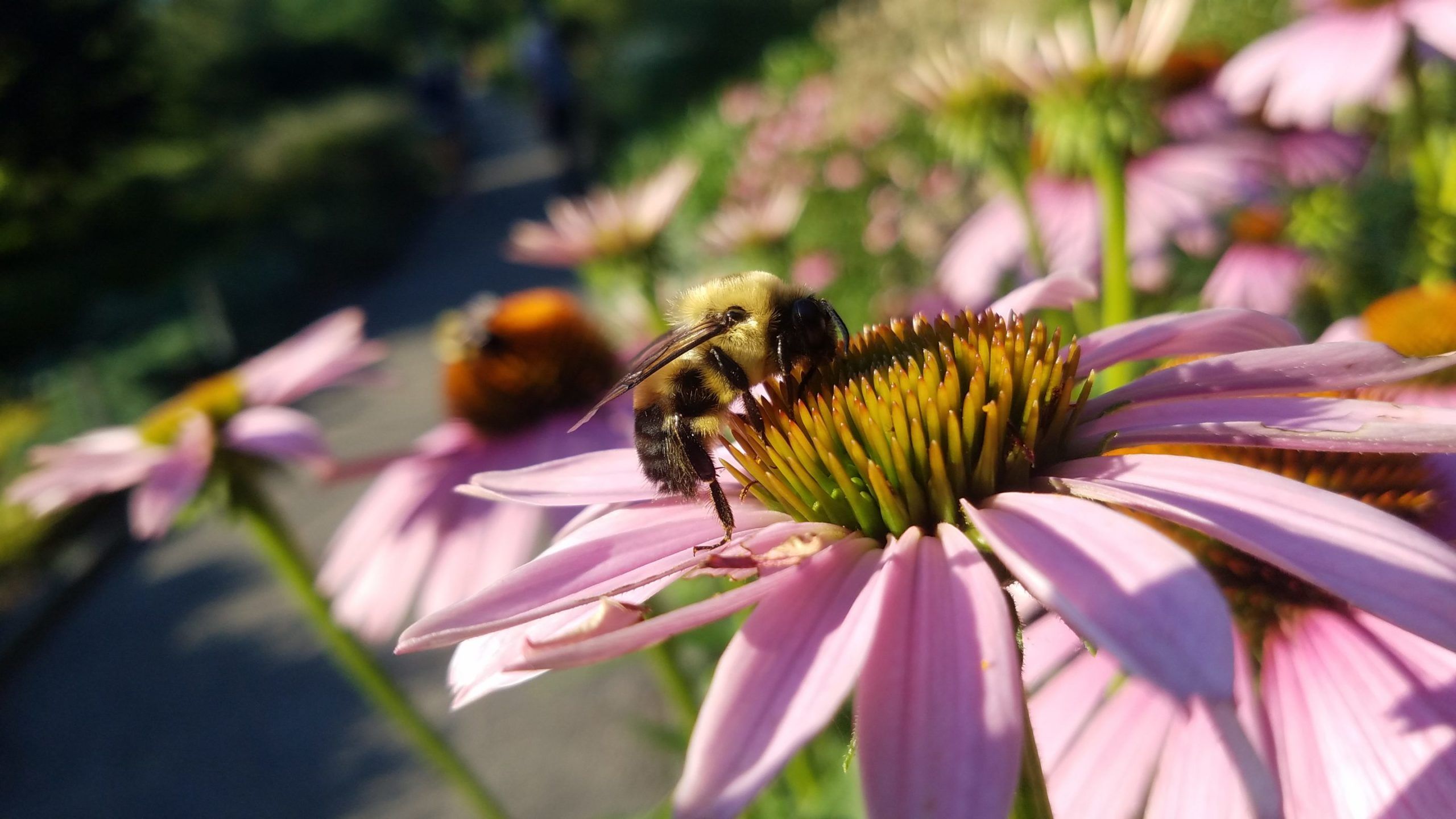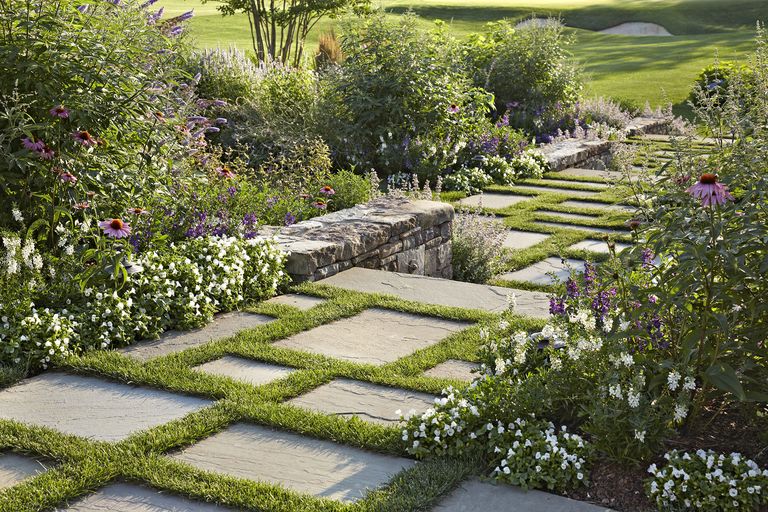How to Create a Beautiful Pollinator Garden in Your Yard
By jessica • April 3, 2023

Is your yard lacking buzz? Is your vegetable garden un-bee-lievably disappointing? Do you need to earn your landscaping wings and bring some life to your space? Time to introduce pollinators! Here’s some helpful tips on how to turn your space into a productive pollinator garden -- but first, let's talk about why that's important!
Why Pollinator Gardens are Important
Our friends at the National Wildlife Federation™ (NWF) share that over 100,000 invertebrates including bees, butterflies, beetles, moths, wasps, and flies—and more than a thousand mammals, birds, reptiles, and amphibians take on the job of pollinating plants. That means we have bees, butterflies, hummingbirds, beetles, and bats to thank for most of our colorful gardens, fruits, and veggies!
You probably remember it from elementary school: the bee flies up to the flower to drink nectar, and gets some pollen on its little feet. Then at the next flower, it drops some of that pollen and plant reproduction can begin. Science is amazing!
According to NWF, bees are the most numerous, effective, and important pollinators. They pollinate both our crops and wild plants, providing us with one-third of the food we eat and allowing wild plants to reproduce and produce the berries, fruits, seeds, and other plant foods that form the base of the natural food web. The domesticated honey bee pollinates the vast majority of agricultural crops.
At the same time, roughly 4,000 species of native bees —some of which are endangered—perform the critically important ecological service of pollinating wild plants across all North American ecosystems. Many bees are generalists, but some are specialized pollinators that require specific host plants to survive. Without healthy habitat, native bumblebees populations decline and our ecosystems weaken.
Why Support Pollinators?
So, why invite all of these critters to your garden? Because we need to help fight the threats to these important pollinators. On a global scale, we’ve all heard that bees and monarch butterflies are in trouble. They are losing numbers due to the mass-spraying of pesticides, loss and fragmentation of habitat, and parasites. With so much of our plants and food depending on them, it’s great to do your part and give them a piece of habitat in your yard. Every little garden helps and creates a pathway for them during migration.
Also, on a personal scale there are also a number of benefits of planting pollinators! This includes:
- They support the overall health of your garden (and local ecosystem). To support your local eco-system you will be planting native plants, which are plants that naturally support your local wildlife.
- Planning your gardens on a bloom schedule is great for pollinators and the year-round color and interest of your space. We always stress year-round interest as important from an aesthetic standpoint, but it's also so important for the surrounding wildlife to survive and thrive.
- Are you growing tomatoes, squash, blueberries, strawberries, or a number of other edibles in your veggie or herb garden? These are all either dependent or aided by pollination by insects. So the more flowers that attract these pollinators - the better overall for your garden.

How Do You Plant a Successful Pollinator Garden?
Now that you know YOU can make a difference and help bees and other pollinators in your own yard, let's learn how to get started. Check out some important steps below.
Choose Plants Wisely - Go Native!
What you plant matters. Research and then grow plants that are native to your surroundings. There are endless lists of native and pollinator plants out there. Check out this great list of host plants by region from NWF.
Here are a handful of Tilly’s surefire favorite plants for making pollinators go wild:
Small, Herbaceous Plants
- Milkweed (Asclepias) – A butterfly favorite!
- Autumn Joy Stonecrop (Sedum ‘Autumn Joy’)
- Allium
- Coneflower (Echinacea)
- Catmint (Nepeta)
Shrubs
- Buttonbush (Cephalanthus occidentalis
- Butterfly bush (Buddleja davidii)
- Rose of Sharon (Hibiscus syriacus)
Trees
- Fruiting trees like apple, pear, peach
- Serviceberry (Amelanchier)
- Crapemyrtle (Lagerstroemia)
*Check if these plants work for your climate and hardiness zone. Some may have specific cultivars that work for your region!
Select Plants for Different Bloom Times
Having lots of beautiful, flowering plants is great, but you definitely don’t want a flourishing cacophony of colors and butterflies in early spring, then a barren wasteland in late fall. Make a quick bloom schedule to ensure that there is nectar that attracts pollinators throughout the different seasons.
Plant in Clumps
A bursting patch of bright red flowers is easier to locate than a lonely salvia. Plant flowers in clumps so the pollinators and other insect pollinators can find you garden.
Avoid Harsh Chemicals and Pesticides
Remember, pesticides are especially harmful. Help all wildlife by eliminating or significantly reducing the use of chemical fertilizers, herbicides and other pesticides. Going chemical-free ensures that your garden is a healthy, safe place for wildlife ~ as well as your pets and family.
If you must resort to chemicals on tough cases such as removal of invasive exotic plants or an infestation, use the most targeted product that breaks down quickly in the environment, and always read and follow the labels.
Non-chemical, organic gardening practices in your garden or landscape are always the best option for wildlife.
Pollinators Need Water!
Provide water. Any type of shallow basin of fresh water will make your yard that much more attractive. Make sure there are low perches for butterflies and bees. If you’re one of the lucky ones, you could get a hummingbird visitor!


Consult with Tilly
If getting started seems overwhelming, you can partner with Tilly to design a Certified Wildlife Habitat® in your yard. The Certified Wildlife Habitat® was developed by the NWF and the initial findings from studies of certified habitats across the country demonstrate that wildlife gardening boosts biodiversity and can make a big difference in your local area.
Meeting the certification requirements include providing shelter, food, water, cover and places to raise young in your yard and committing to adopt some sustainable gardening practices. Meeting many of these requirements can be as easy as adding native plants to your landscape! Your designer can share more information on the process and make it easy for you to make a difference in your own yard.








We hope this article helped inform you on why pollinator gardens are so critical and why they would be a great addition to your yard!
About Tilly
Tilly’s easy online landscape design process has been embraced by homeowners across the country and in Canada. From Texas, Florida, Colorado to Illinois - we have a team for you! Tilly designs front yards, backyard or your entire property. We match you with a professional landscape designer who is familiar with your region to help you create the perfect custom plan for your outdoor space.
To start our process you’ll fill out a questionnaire about your property that helps our design team understand your goals, needs and existing landscape. You can add 3d renders, lighting plans or side yards to your design package. You’ll then connect with your designer on a video call to meet them, show them your space and talk about your priorities.
When you receive your design you will be able to purchase your plants at a discounted rate through our team of plant experts and have them delivered directly to your curb. Tilly can also provide recommendations of local installers who can help you complete your landscape project.
Tilly also offers individual DIY projects. With DIY Spaces, you are matched with a landscape designer who will design a custom project for your yard. This will include a scaled drawing, lists of materials (which you can order directly through Tilly to install your project) and detailed installation instructions to help even a first time DIY’er tackle a yard project!
Wherever you are in your yard journey, we can help!
Read more about: Gardening Tips, Tips